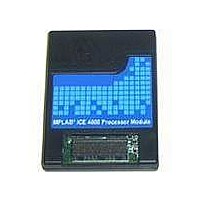PMF18WE1 Microchip Technology, PMF18WE1 Datasheet - Page 76

PMF18WE1
Manufacturer Part Number
PMF18WE1
Description
PROCESSOR MODULE FOR ICE4000
Manufacturer
Microchip Technology
Datasheet
1.ICE4000.pdf
(98 pages)
Specifications of PMF18WE1
Module/board Type
Processor Module
Product
Microcontroller Modules
Core Processor
PIC18F6585/6680/8585/8680
Lead Free Status / RoHS Status
Contains lead / RoHS non-compliant
For Use With/related Products
ICE4000
Lead Free Status / RoHS Status
Lead free / RoHS Compliant, Contains lead / RoHS non-compliant
MPLAB
DS51490A-page 70
ICE 4000 User’s Guide
MPLAB ICE 4000 driver not loaded on installation
If you did not install the MPLAB ICE 4000 driver according to the instructions displayed
at MPLAB IDE installation and a standard Windows driver has been used instead,
MPLAB ICE 4000 will not work. Follow the directions in the file MPUsbClean.htm
found in the Driversnn\ICE4k_USB subdirectory of the MPLAB IDE installation
directory, where nn is the version of Windows OS. Then go to Section 2.4 “Driver and
Software Installation” to install the correct driver.
Cannot select MPLAB ICE 4000 from MPLAB IDE Debug menu
For some operating systems, like Windows XP, you may have to wait up to 10 seconds
from the time you power your USB device until the device is recognized by the
operating system and thus allows MPLAB IDE to see it.
Single stepping extremely slow when programmer enabled
When using MPLAB ICE 4000 to emulate a part with EEDATA, if you have a
programmer enabled your stepping through code will be very slow. Disable to the
programmer to speed up stepping time.
The slowdown occurs because the programmer must attach to the entire range of
EEDATA so it can be programmed. The debugger, seeing that someone is attached to
the EEDATA (whether a programmer or EEDATA Display) will read back the entire
range after each step in case the data was modified while running.
Single stepping extremely slow
In general, to speed up execution when single stepping through code, close the
following windows: EEDATA, Stack and SFR/GPR window. The EEDATA and Stack
windows require extra time to populate with data. The SFR/GPR window requires more
time simply because of the large number of registers it may contain. In this case, you
may want to consider using a Watch window.
Additionally, select Debugger>Settings, Clock tab and choose to either check the
check box for “Optimize for Fast Step” or change the frequency to be faster while
stepping.
For some newer PMFs, if you are using a low frequency clock, you can speed stepping
by selecting “Enable Fast Oscillator While Halted” on the Debugger>Settings, Clock
tab. This allows the PMF/PCM to switch frequencies while stepping to a 10 MHz clock.
However, you should be careful using this feature:
• If you are using an oscillator mode that uses the pin OSC2 as an output with
• If you are running with peripherals not frozen, the peripherals operation will
F
This is to avoid enabling a feature that would cause the OSC2 pin to go from its
current operating frequency / 4 to 10 MHz / 4. However, you can still use the fast
oscillator by selecting the checkbooks “Enable Fast Oscillator Even When OSC2
is clock out”.
change when you step to 10 MHz.
OSC
/4, the “Enable Fast Oscillator While Halted” check box will be grayed out.
2004 Microchip Technology Inc.











